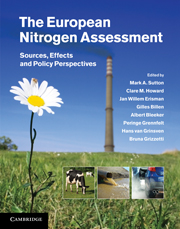Book contents
- Frontmatter
- Contents
- List of contributors
- Foreword
- Summary for policy makers
- Technical summary
- 1 Assessing our nitrogen inheritance
- Part I Nitrogen in Europe: the present position
- 2 The European nitrogen problem in a global perspective
- 3 Benefits of nitrogen for food, fibre and industrial production
- 4 Nitrogen in current European policies
- 5 The challenge to integrate nitrogen science and policies: the European Nitrogen Assessment approach
- Part II Nitrogen processing in the biosphere
- Part III Nitrogen flows and fate at multiple spatial scales
- Part IV Managing nitrogen in relation to key societal threats
- Part V European nitrogen policies and future challenges
- Glossary
- Index
- References
5 - The challenge to integrate nitrogen science and policies: the European Nitrogen Assessment approach
from Part I - Nitrogen in Europe: the present position
Published online by Cambridge University Press: 16 May 2011
- Frontmatter
- Contents
- List of contributors
- Foreword
- Summary for policy makers
- Technical summary
- 1 Assessing our nitrogen inheritance
- Part I Nitrogen in Europe: the present position
- 2 The European nitrogen problem in a global perspective
- 3 Benefits of nitrogen for food, fibre and industrial production
- 4 Nitrogen in current European policies
- 5 The challenge to integrate nitrogen science and policies: the European Nitrogen Assessment approach
- Part II Nitrogen processing in the biosphere
- Part III Nitrogen flows and fate at multiple spatial scales
- Part IV Managing nitrogen in relation to key societal threats
- Part V European nitrogen policies and future challenges
- Glossary
- Index
- References
Summary
Executive summary
Nature of the problem
Anthropogenic releases of reactive nitrogen (Nr) can disturb natural systems and affect human health and welfare in many different ways. Scientific and policy views of the nitrogen cycle have typically addressed these problems from separate perspectives, looking in each case at only part of the overall issue.
Given the multi-faceted nature of the nitrogen cycle, it is a major challenge to develop a more-integrated understanding of how different areas of nitrogen science and policies fit together.
Approaches
Observations from the first part of the European Nitrogen Assessment (ENA Part I) are summarized, considering the distinctive character of Nr in Europe, the benefits and threats, and the current policies. Approaches to developing the following parts of the Assessment are discussed with an emphasis on how to draw out the key issues.
Key findings
Recognizing the multi-pollutant, multi-phase complexity of the nitrogen cycle, it is concluded that it is essential to focus on a limited set of priority issues to allow effective communication between nitrogen scientists and policy makers.
A pathway is developed for prioritization of the key environmental concerns of excess Nr. Starting with around twenty environmental effects, the list is reduced down, first to nine main concerns, and then to five key societal threats.
[…]
- Type
- Chapter
- Information
- The European Nitrogen AssessmentSources, Effects and Policy Perspectives, pp. 82 - 96Publisher: Cambridge University PressPrint publication year: 2011
References
- 27
- Cited by

